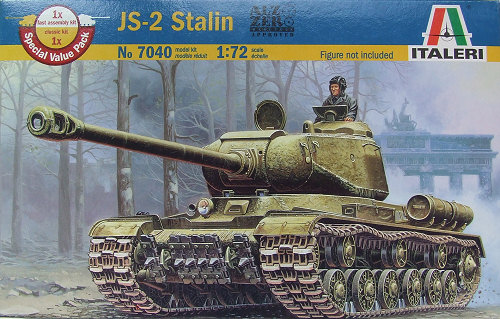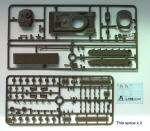
| KIT: | Italeri 1/72 JS-2 Stalin |
| KIT #: | 7040 |
| PRICE: | $ |
| DECALS: | Four options |
| REVIEWER: | Peter Hobbins |
| NOTES: | Includes a 'fast assembly' version. |

| HISTORY |
Easily one of the most potent tanks to see wide-scale service in World War II, the JS-2 (or IS-2 if you prefer) served from the start of 1944 through until the late 1960s, although by then they were quite outmoded. In their prime, Guards units equipped with these heavily armed monsters spearheaded much of the Red Army’s push on Berlin. The 122 mm gun was powerful enough to rip the frontal armour off a Panther, although it was slow to reload and the tank could only carry 28 rounds (versus 81 in the Panther). While heavily armoured, manufacturing quality shortfalls meant that the Stalin was not as well protected as it should have been. Nevertheless, in action the tank performed very well against Panthers and Tigers (perhaps the nearest German equivalents in terms of weight and firepower), while no slouch against the Tiger II. Indeed, even into the 1950s the threat of intervention by Chinese JS-2s scared both the French in Indo-China and the United Nations in Korea (although in neither case were they widely deployed).
| THE KIT |
Italeri have always been good at identifying market niches (look at their dominance in the 1:72 helicopter field, for instance, or their series of transports and gliders of World War II). In the small-scale armour scene they have chosen to aggressively target wargamers, who generally require vast numbers of robust kits to fill out their tables. So it is with this kit, which is available both in this format (one ‘classic kit’ and one ‘fast assembly’ version), and in a twin-pack of fast-assembly Stalins. Italeri have also sensibly used some of the JS-2 moulds for their ISU-152 release.
 Let’s
start with the easy one: the fast-assembly kit. This comprises a mere 11 pieces
and by my best estimate could be prepared and assembled in less than 10 minutes.
The components are nicely detailed although of necessity simplified. This is
most apparent when looking at the running gear and tracks: the latter have only
smooth surfaces on the inner and outer links, and there are a few sink marks
where the plastic was not quite injected properly. I think Italeri could have
actually moulded the running gear as one piece and the tracks as another that
could then slide over the top, which would have allowed them to incorporate some
of the prominent teeth and perhaps a little more link detail, without
dramatically slowing assembly. Indeed, I think it is the tracks that would put
any ‘serious’ modeller off making too much of an effort with the fast assembly
kit. But don’t get me wrong – I will no doubt have fun building it and can then
use it to practice painting one of the more demanding schemes on offer.
Let’s
start with the easy one: the fast-assembly kit. This comprises a mere 11 pieces
and by my best estimate could be prepared and assembled in less than 10 minutes.
The components are nicely detailed although of necessity simplified. This is
most apparent when looking at the running gear and tracks: the latter have only
smooth surfaces on the inner and outer links, and there are a few sink marks
where the plastic was not quite injected properly. I think Italeri could have
actually moulded the running gear as one piece and the tracks as another that
could then slide over the top, which would have allowed them to incorporate some
of the prominent teeth and perhaps a little more link detail, without
dramatically slowing assembly. Indeed, I think it is the tracks that would put
any ‘serious’ modeller off making too much of an effort with the fast assembly
kit. But don’t get me wrong – I will no doubt have fun building it and can then
use it to practice painting one of the more demanding schemes on offer.
 The
full kit is a very nice piece of work, and while based on similar masters is
moulded with many additional details. There is a nice cast texture on the turret
and glacis; some will say this is too prominent, but as always this is personal
– to me the cast effect is visible even in grainy wartime shots of the JS-2. The
running gear and tracks are beautifully detailed, including both sides of the
road wheels. The outer faces of the track links are excellent; the insides not
quite so good and marred a little by ejector pin marks (thankfully these are
raised rather than recessed, which makes sanding them off easier). PST brought
out a set of link-and-length JS-2 tracks a few years ago and these provide an
interesting contrast – their exterior faces are not as good as the Italeri ones,
but the inside detail is better. I think the wheels on the PST JS-2 are also
slightly more accurate than on the Italeri offering, but both are nice.
The
full kit is a very nice piece of work, and while based on similar masters is
moulded with many additional details. There is a nice cast texture on the turret
and glacis; some will say this is too prominent, but as always this is personal
– to me the cast effect is visible even in grainy wartime shots of the JS-2. The
running gear and tracks are beautifully detailed, including both sides of the
road wheels. The outer faces of the track links are excellent; the insides not
quite so good and marred a little by ejector pin marks (thankfully these are
raised rather than recessed, which makes sanding them off easier). PST brought
out a set of link-and-length JS-2 tracks a few years ago and these provide an
interesting contrast – their exterior faces are not as good as the Italeri ones,
but the inside detail is better. I think the wheels on the PST JS-2 are also
slightly more accurate than on the Italeri offering, but both are nice.
Italeri have been listening to modellers with regard to detail parts too: the hatches can be posed open and are excellently detailed on both sides, while the pioneer tools, lifting eyes, and even desant rider grab-rails are all moulded separately and look pretty good. The limits of the manufacturer’s moulding technology can be seen in the external fuel tanks and the engine grilles, which could be crisper (the grilles also have a diagonal pattern, as opposed to the meshwork on the real thing). Perhaps my major complaint is what is not there, namely the turret-mounted DshK machine gun, tow cables, and crew. To be fair, the MGs were not present on many wartime JS-2s, but it would have been nice to include one (or two!) anyways. Italeri (and ESCI before them) excelled in the provision of beautiful crew figures, and it’s a real shame that one or two tankers couldn’t have been included on the sprues somewhere. However, these are minor quibbles; I have the Extratech photoetch set designed for the PST kit (which really needs help with the finer details), and I doubt that I will use many parts from it when building Italeri’s offering.
The instructions are commendably clear, including a full sprue layout, and the kit offers four marking options. One of these has no insignia at all, while for the other three options the individual vehicle number is provided on a decal sheet printed by Zanchetti. This is fine – you can choose between green, whitewashed or camouflaged vehicles – but one plus of the PST kit was their great decal sheet with some really interesting markings.
| CONCLUSIONS |
Overall this is
a really nice kit of a significant tank, and it deserves to sell well. In terms
of dimensions and details it looks about right (the two sets of plans I have
differ from each other, and also from this kit!), and while the moulding isn’t
quite as crisp as some other manufacturers, it is more than acceptable. I just
hope that they move on to provide some neglected American armour such as the M18
Hellcat or M26 Pershing! 
After completing my preview, I couldn’t resist building up the fast-assembly kit. From first cut to final assembly took 35 minutes, most of that scraping and sanding seams, especially on the external fuel tanks. The finished product is unavoidably toy-like, especially the hollow turret and simplified running gear; in appearance and ‘feel’ it’s similar to the popular Roco 1:87 Minitanks range. Nevertheless, it offers a quick and sturdy product that could easily help fill a wargames table, or encourage junior modellers to take up the hobby.
| REFERENCES |
Tim Bean and Will Fowler. Russian Tanks of World War II: Stalin’s Armoured Might. London: Amber Books, 2002.
Steve Zaloga. IS-2 Heavy Tank 1944–73. Oxford: Osprey Publishing, 1994.
Nicola Cortese. Modelling the IS Heavy Tank. Oxford: Osprey Publishing, 2004.
If you would like your product reviewed fairly and quickly by a site that has over 350,000 visitors a month, please contact me or see other details in the Note to Contributors.